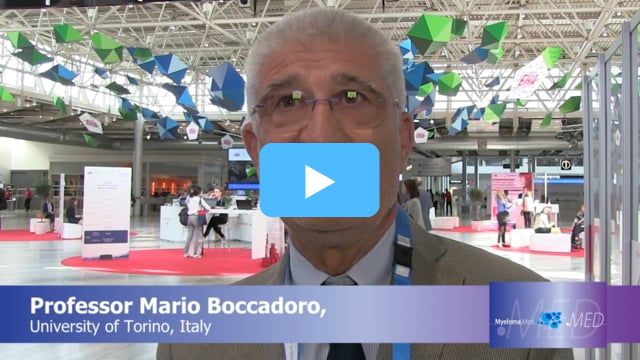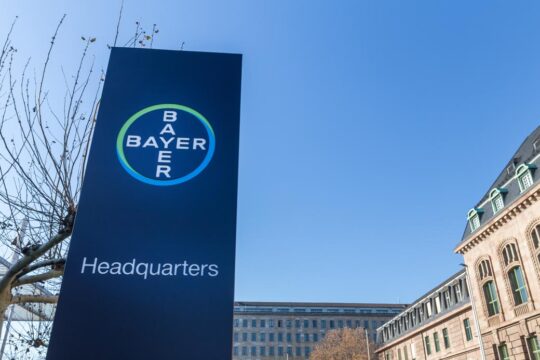Advertisment
EHA 2018: The Issue of Frailty in MM

When treating patients with MM frail patients are less able to tolerate aggressive treatment and therefore have poorer OS. In the era of novel agents there is a medical need for maximising tolerability and optimising efficacy in elderly patients by individualising therapy based on fitness rather than chronological age. Professor Sonja Zweegman from Amsterdam hosted a Meet the Expert session at EHA 2018 which highlighted some of the challenges around detecting and assessing frailty and adapting therapy so that frail patients can achieve the best possible outcome.
Author: Maria Dalby. Interviewer: Esther Drain.
Professor Mario Boccadoro (Italy) gives his thoughts on the issue of frailty in MM, and that it may account for differences in treatment outcomes between RCTs and the real-world.
Professor Zweegman reminded the audience that advanced chronological age as such is not a barrier to deriving clinical benefit from novel treatments in multiple myeloma (MM). Several large well-designed clinical trials including VISTA,1 FIRST,2 MM-010,3 and recently the ALCYONE study4 have shown that elderly patients benefit from treatment with IMiDs and/or proteasome inhibitors in terms of prolonged OS. This is reflected in real life clinical practice, where MM patients aged >75 years who receive MP, MPT MPV or Rd have been shown to achieve comparable PFS rates to patients aged 65 to 75 years.5 However, OS rates are lower among elderly patients in real life which Professor Zweegman attributes to toxic side effects from first line treatment which preclude second-line treatment. Among elderly patients, grade 3-4 non-haematological toxicity and treatment discontinuation are associated with increased mortality which highlights the need for adapting therapy to allow these patients to remain on treatment.6 However, chronological age does not necessarily reflect a person’s biological age and the therapy should therefore be adapted based on whether the patient is fit or frail.
In most centres, including Professor Zweegman’s own centre in Amsterdam, a simple eyeball assessment is done in the clinic to judge an elderly MM patient’s level of fitness. Patients aged 65-70 years may be eligible for autologous stem cell transplantation provided they are fit – additional geriatric assessments may be performed if required. The G8 is a gold-standard screening tool for assessing fitness in older cancer patients;7 however, the most relevant tool for use in MM is the IMWG frailty score which has been developed to predict OS in MM patients aged 75 and over based on the tools Activities of Daily life (ADL), Instrumental Activities of Daily Life (IADL), and Charlson Co-morbidity Index (CCI) and which is significantly associated with OS, non-haematological toxicity and discontinuation rate.8 EQ-5D scores can be used to extrapolate ADL and IADL scores in retrospective cohorts; results from the FIRST trial that have been submitted for publication show that frailty based on EQ-5D scores significantly predicts PFS and OS outcomes following treatment with Rd and MPT. The UKMRA Myeloma XIV FITNEsS (Frailty-adjusted therapy in transplant non-eligible patients with symptomatic myeloma) study is due to begin later this year; in this study 740 elderly MM patients will be randomised to receive either reactive, non-adjusted induction therapy with either CRd or ixazomib, lenalidomide and dexamethasone (NRd), or adaptive therapy with frailty index-adjusted CRd or NRd induction. Patients will receive six to eight cycles until maximum response and then begin maintenance therapy with R or NR.
Professor Paul G. Richardson (Boston) and Dr Karthik Ramasamy (Oxford) highlight the new developments for patients who are newly diagnosed with MM, and ineligible for a stem cell transplant.
In frail elderly MM patients, a two-drug bortezomib-containing regimen may offer comparable survival and response outcomes to regimens containing three drugs but with lower discontinuation rates, thus allowing more patients to reach maintenance therapy.9 Similar results have been shown for two- and three-drug lenalidomide-containing regimens.10 The biggest challenge with using two-drug IMiD and PI regimens in frail patients is the dexamethasone component, and Professor Zweegman advised that the dexamethasone dose should be reduced to 20mg once weekly. In the HOVON 123 study in elderly unfit and frail MM patients, half of the frail patients failed to complete nine cycles of VMP; however, 70% were able to complete six cycles with comparable ORR and VGPR rates to unfit patients.11 Most early deaths in elderly MM patients are due to infections, and Professor Zweegman recommended vaccination as an additional precaution for this reason.
A poster presented by the Swedish Myeloma Registry Group at EHA 2018 showed that among patients who were diagnosed with MM at the age of 66 to 80 years, survival rates improved significantly from the period 2008-2011 (3-year relative survival [RS] 61.7%; 95% CI 58.8-64.8%) to the period 2011-2016 (3-year RS 70.7%; 95% CI 68.0-73.5%) (poster PF590).
Sara Bringhen and colleagues from the University of Turin presented a subgroup analysis from the EMN01 study which confirmed Professor Zweegman’s point that while fit patients derive benefit from a triplet full-dose lenalidomide-containing regimen, unfit and frail patients are more likely to do well on a gentler doublet regimen. Median OS among patients receiving MPR or CPR was 83 months, versus 50 months in the Rd arm (HR=0.69, p=0.09); in contrast, frail patients who received Rd had a five-year OS of 44%, compared with 46% among fit patients on Rd. All patients benefited from lenalidomide maintenance therapy (poster PS1293).
References
- San Miguel JF, Schlag R, Khuageva NK, et al. Persistent overall survival benefit and no increased risk of second malignancies with bortezomib-melphalan-prednisone versus melphalan-prednisone in patients with previously untreated multiple myeloma. J Clin Oncol 2013;31:448-55.
- Hulin C. EFFECT OF AGE ON EFFICACY AND SAFETY OUTCOMES IN PATIENTS WITH NEWLY DIAGNOSED MULTIPLE MYELOMA RECEIVING LENALIDOMIDE AND LOW-DOSE DEXAMETHASONE (RD): THE FIRST TRIAL. Haematologica 2015;100:1-804.
- Dimopoulos MA, Palumbo A, Corradini P, et al. Safety and efficacy of pomalidomide plus low-dose dexamethasone in STRATUS (MM-010): a phase 3b study in refractory multiple myeloma. Blood 2016;128:497-503.
- Mateos MV, Dimopoulos MA, Cavo M, et al. Daratumumab plus Bortezomib, Melphalan, and Prednisone for Untreated Myeloma. N Engl J Med 2018;378:518-528.
- Hulin C, Rodon P, Campion L, et al. Clinical Characteristics, Chromosomal Abnormalities and Outcomes in Very Elderly Patients with Multiple Myeloma: The IFM Experience. Blood 2012;120:204-204.
- Bringhen S, Mateos MV, Zweegman S, et al. Age and organ damage correlate with poor survival in myeloma patients: meta-analysis of 1435 individual patient data from 4 randomized trials. Haematologica 2013;98:980-7.
- Kenis C, Decoster L, Van Puyvelde K, et al. Performance of two geriatric screening tools in older patients with cancer. J Clin Oncol 2014;32:19-26.
- Palumbo A, Bringhen S, Mateos MV, et al. Geriatric assessment predicts survival and toxicities in elderly myeloma patients: an International Myeloma Working Group report. Blood 2015;125:2068-74.
- Niesvizky R, Flinn IW, Rifkin R, et al. Community-Based Phase IIIB Trial of Three UPFRONT Bortezomib-Based Myeloma Regimens. J Clin Oncol 2015;33:3921-9.
- Larocca A. Abstract presented at the 14th International Myeloma Workshop. Clinical Lymphoma Myeloma and Leukemia;13:S1-S260.
- Zweegman S, Levin M-D, Klein SK, et al. Feasibility and Efficacy of Dose Adjusted Melphalan – Prednisone – Bortezomib (MPV) in Elderly Patients ≥ 75 Years of Age with Newly Diagnosed Multiple Myeloma; the Non-Randomised Phase II HOVON 123 Study. Blood 2016;128:3305-3305.





